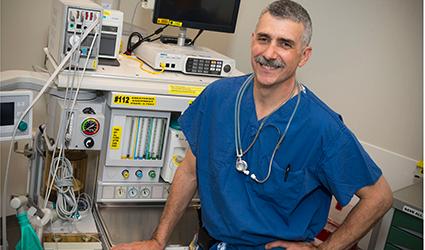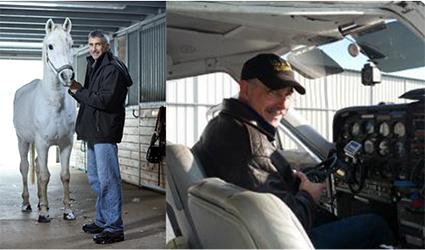
In the operating room, the surgeon may be the captain of the ship, but when something goes wrong, everyone turns to the anesthesiologist.
“In a way, it’s one of the reasons I chose the specialty,” says Johns Hopkins Children’s Center pediatric anesthesiologist Robert S. Greenberg, above, who took part in a recent interview. “Your job is to have the most comprehensive view of the patient. You are the general pediatrician in the OR.”
Anesthesiologists are not only the experts in airway management and resuscitation in the OR, but the crisis masters. “We are the ones behind the screen, if you will, negotiating the medical pathways, monitoring the patient’s vitals,” says Greenberg. “Our role is to make sure the whole patient is managed while the surgeon operates. Should something go wrong, we know where that child is, physiologically, and where he or she is in trouble.”
With a medical degree from Georgetown, Greenberg completed a pediatric residency at Johns Hopkins in 1988, followed by a residency in anesthesiology and critical care medicine 1991, then fellowships in pediatric critical care and pediatric anesthesiology.
That’s a lot of training. What drew you to pediatric anesthesiology?
I’ve wanted to be a pediatrician since the third grade. My plan was to be a country doctor and accept things like pigs and chickens as payment. I decided I’d accept anything, do anything to take care of your kids.
Early in my pediatric residency at Johns Hopkins, I was drawn to critical care medicine. I thought the life of an intensivist was for me. The dogma at the time in the mid-1980s was that to be an intensivist you first had to be an anesthesiologist. As I began training in anesthesiology, I realized how much I liked anesthesiologists’ comprehensive role in caring for their patients, from home to the OR, to the PICU (pediatric intensive care unit), and sometimes back again. I became an expert in pediatric anesthesia and, in particular, airway management; board-certification in pediatric anesthesiology came this year. It was the first time it was ever offered.
What is the anesthesiologist’s role in managing patients beyond the OR?
At a place like Johns Hopkins, where pediatric patients are among the sickest of the sick and their surgeries are among the most complex and sophisticated in American medicine, we commonly take care of kids that others are afraid to. We’re called up to practice highly integrated medicine. On the units and in the PICU, we are called in for consultation and assistance with multiple procedures, including airway or nerve blocks, as well as perioperative and medical pain management. Pediatric pain management is a practice that Johns Hopkins not only helped to start but takes very seriously. It’s a big part of our daily jobs.
Tell us more about pain management in children.
I would say our pain management group is a pillar of the Children’s Center. Controlling a child’s pain takes a tremendous amount of work, but it changes lives. Take an obvious example of exstrophy, a condition in which a baby’s born with his or her bladder outside the body. We have world experts here to address this surgically, but these babies need to be immobilized from the belly button down for six weeks; so, we place a pain catheter in the newborn. The pain team keeps them comfortable and peaceful, so they can interact with their parents and meet some developmental milestones, even in the hospital, while they heal.
You seem to be part of a lot of teams here.
We all are. We’ve loads of expertise in this place and all of us come together to help our kids. In the OR, where I spent a lot of my time, the surgeons, radiologists, nurses, intensivists all do their best to work together as a single unit. We eat at each other’s houses; we take care of these kids together. And you could say that in the OR environment, anesthesiologists are the grease that helps keep all the parts working.
How so?
I’ll give you an example. A child who’d been seen by other docs in another hospital came to see us at Johns Hopkins. He had a voice problem. I anesthetized him so the otolaryngologists could look at his vocal cords. When a child has a vocal cord problem, you don’t know what might be down there until you look. So I ventilated him while an otolaryngology colleague and others evaluated him. They noticed the boy’s vocal cords weren’t moving; we looked at each other and had to rethink. Usually that means the problem is in the brain, that for some reason the cords aren’t getting the message to move properly. The best thing was to go straight to MRI and evaluate what was going on. But these things usually take weeks to schedule – requiring yet another anesthetic and a delay in solving the child’s problem. So another colleague and I negotiated with the anesthesiologist, working in radiology that day, to make room for this child. Great care is all about flexibility and adaptability. We brought the child – still under anesthesia – from the OR to the MRI suite. Now most young kids have to be medicated for this type of procedure, anyway; they squirm and it’s scary for them. This is why there’s an anesthesiologist in the MRI. So he monitored the child, still asleep, so radiologists could get the best scans. Turns out the child had a significant Chiari malformation that was causing the problem. The malformation squeezes the brain down into the neck, causing the vocal cord problem. After learning this, I was off to find a neurosurgeon. Pediatric neurosurgeon Edward Ahn said he needed to evaluate the child first, and this meant temporarily awakening the child. So we changed the anesthetic a bit, to wake the child so Dr. Ahn could do his assessment, then we put him back to sleep, and he had the neurosurgery he really needed. This child went from an ENT evaluation to MRI, to brain surgery – all under an anesthesiologist’s care. And along the way, we kept talking with his family, to let them know what was going on, to answer their questions, to keep them involved, and let them know we cared. I don’t know what counts as platinum care, but this child got it at Johns Hopkins.
Are you involved in research?
Yes. We’re always working to improve care. I study, among other things, pediatric acute pain management and how best to monitor nerve blocks. When I’m not in the OR, or with a patient these days, I’m studying devices I invented with colleagues in the Johns Hopkins Applied Physics Lab. We’re studying one in piglets now. It indicates how well an epidural is working. So, maybe in the future we’ll be able to more safely control pain in even the littlest of babies.
How do you like to relax when you’re not at Johns Hopkins?
It’s important to take time away from the intensity and the pressure of work. I like managing my horse farm and flying my Cessna Cardinal. Flying plays to my level of critical thinking, risk management and, above all, safety. I follow the basic three types of flight missions: fly around the airport to practice essential skills, go for the “$200-dollar hamburger” (which means you fly to another airport and have a nice lunch somewhere), or travel to a destination like Cape May or Tangier Island. I used to fly to visit my kids when they were in college. I delivered care packages to them in Ithaca, Cleveland, and Burlington, N.C.

What keeps you going?
My patients and their families. Don’t tell my secret: I love what I do, with all its challenges and the harrowing experiences when a patient is in difficulty. The fun part comes when a parent sends me a Christmas ornament that says “Dr. Greenberg says, ‘Don't Make Me Drug You!’” Or when you come into a patient’s room, and the family’s so comfortable with you that mom can joke: “How can I miss you if you won’t go away?” I know that’s her way of saying “Thanks for coming by to see my child.”
